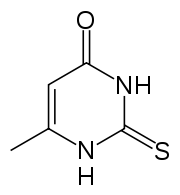Thioureas
Thioureas are members of a family of organosulfur compounds with the formula SC(NR2)2. The parent member of this class of compounds is thiourea SC(NH2)2. The thiourea functional group has a planar CSN2 core.

Synthesis
N,N′-unsubstituted thioureas can be prepared by treating the corresponding cyanamide with hydrogen sulfide or similar sulfide sources.[1]
Alternatively, N,N′-disubstituted thioureas can be prepared by coupling two amines with thiophosgene:[2]
- 2 R2NH + CSCl2 + 2 (R2N)(R′2N)CS + 2 HCl
Amines also condense with organic thiocyanates to give thioureas:[3]
- R2NH + R′NCS → (R2N)(HR′N)CS
Cyclic thioureas are prepared by transamidation of thiourea with diamines. Ethylene thioureais synthesized by treating ethylenediamine with carbon disulfide.[4] In some cases, thioureas can be prepared by thiation of ureas using phosphorus pentasulfide.

Applications
Precursor to heterocycles
Thioureas are building blocks to pyrimidine derivatives. Thus thioureas condense with β-dicarbonyl compounds.[5] The amino group on the thiourea initially condenses with a carbonyl, followed by cyclization and tautomerization. Desulfurization delivers the pyrimidine. The pharmaceuticals thiobarbituric acid and sulfathiazole are prepared using thiourea.[6] 4-Amino-3-hydrazino-5-mercapto-1,2,4-triazole is prepared by the reaction of thiourea and hydrazine.
Catalysis
Some thioureas are vulcanization accelerators. Thioureas are also used in a research theme called thiourea organocatalysis.[7]
References
- ↑ Koketsu, Mamoru; Kobayashi, Chikashi; Ishihara, Hideharu (2003). "Synthesis of N-aryl-S-alkylthiocarbamates". Heteroatom Chemistry. 14: 374–378. doi:10.1002/hc.10163.
- ↑ Yi-Bo Huang, Wen-Bin Yi, Chun Cai (2012). "Thiourea Based Fluorous Organocatalyst". Top. Curr. Chem. 308: 191–212. doi:10.1007/128_2011_248.
- ↑ Miyabe, H.; Takemoto, Y. (2008). "Discovery and Application of Asymmetric Reaction by Multifunctional Thioureas". Bull Chem Soc Jpn. 81: 785.
- ↑ C. F. H. Allen; C. O. Edens; James VanAllan. "Ethylene Thiourea". Organic Syntheses. ; Collective Volume, 3, p. 394
- ↑ Foster, H. M., and Snyder, H. R. (1963). "4-Methyl-6-hydroxypyrimidine". Organic Syntheses. ; Collective Volume, 4, p. 638
- ↑ Bernd Mertschenk, Ferdinand Beck, Wolfgang Bauer (2002). "Thiourea and Thiourea Derivatives". Ullmann's Encyclopedia of Industrial Chemistry. Wiley-VCH. doi:10.1002/14356007.a26_803.
- ↑ R. Schreiner, Peter (2003). "Metal-free organocatalysis through explicit hydrogen bonding interactions". Chem. Soc. Rev. 32: 289–296. doi:10.1039/b107298f. PMID 14518182.
Further reading
- Patai, S., ed. (1977). The Chemistry of double-bonded functional groups. New York, NY: John Wiley & Sons. pp. 1355–1496. ISBN 0-471-92493-8.